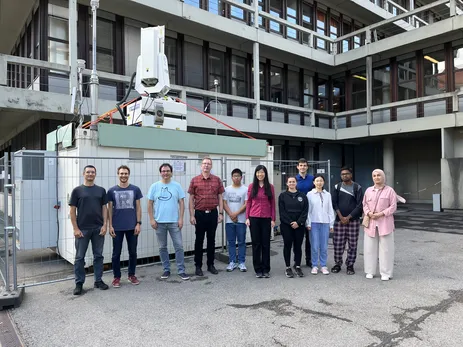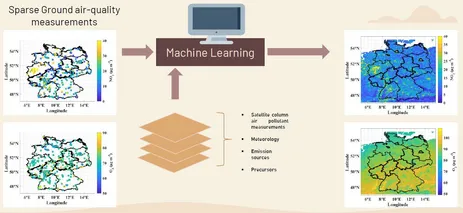We are currently engaged in several different major projects as research partners or science leads.
Hans Fischer Project
Building upon our previous research works, we have come to understand that German metropolitan areas do not exhibit improvements in air quality despite decreasing emissions. This is particularly evident concerning secondary air pollutants such as O3 and PM2.5. The primary factor behind this issue is the non-linear chemistry that interacts between primary emissions and the formation of secondary pollutants.
The primary objective of this project is to address a pivotal question: When and which emissions can be effectively reduced to genuinely enhance air quality in Munich? A collaborative effort between three distinguished groups - Technical University of Munich (Dr.-Ing. Jia Chen), Harvard University (Dr. Frank N. Keutsch), and Karlsruhe Institute of Technology (Dr. Harald Saathoff) - aims to comprehensively understand and improve air quality in Munich.
To address this complexity and pave the way for a cleaner future, the project focuses on gaining crucial insights into secondary pollutant formation and the role of precursors like NOX and various VOCs. In 2023 (summer) and 2024 (winter), a planned campaign will measure secondary pollutants and their precursors through real-time measurements. This data, combined with advanced modeling tools, will enable the identification of suitable mitigation strategies.
Furthermore, the project will explore the potential of machine learning algorithms in modeling air pollutant concentrations1. Additionally, there will be an effort to enhance the Chemical Transport Model (e.g., Geos-Chem) performance through the integration of machine learning models. Through this collaboration, the project aspires to contribute meaningful solutions that can benefit not only Munich but also inspire similar initiatives worldwide, ensuring a healthier and cleaner future for all. Funding for this significant endeavor is generously provided by the Institute for Advanced Studies (IAS), Technical University of Munich, under the prestigious Hans Fischer Senior Fellowship.
1Balamurugan, V., Chen, J., Wenzel, A., and Keutsch, F. N.: Spatio-temporal modeling of air pollutant concentrations in Germany using machine learning, Atmos. Chem. Phys., 2023.
ICOS Cities PAUL (Pilot Application in Urban Landscapes)

Project description
Cities are emission hotspots and play an important role in emission reduction efforts. Observing and verifying greenhouse gas emissions from densely populated urban areas is essential. The EU-funded project PAUL (ICOS Cities) will develop and evaluate innovative greenhouse gas measurement technologies and observatories. The aim is to provide unique data sets feeding diverse models and scientific studies, while testing the feasibility of modelling approaches in various areas. Moreover, the project will help cities execute their climate action goals by providing data on fossil fuel emissions from urban areas. Pilots will be conducted in Munich, Paris and Zurich. For increased impact, 12 other European cities are included in the city network.
We will complement our existing MUCCNet high-precision sensor network in Munich with 20 mid-cost and 100 low-cost CO2 sensors. This provides exceptional spatial coverage of the urban area and an unprecedented opportunity to model urban emissions with a high spatial and temporal resolution. Furthermore, we develop bottom-up emission estimates for key-emitting sectors like power generation, heating and traffic. These so-called emission inventories are combined with national data to obtain a complete picture Munich's annual emissions.
Project details
Project duration: 2021 - 2025
Funding: European Commission - Horizon 2020 - Grant agreement ID: 101037319
VUCL (Vienna Urban Carbon Laboratory)
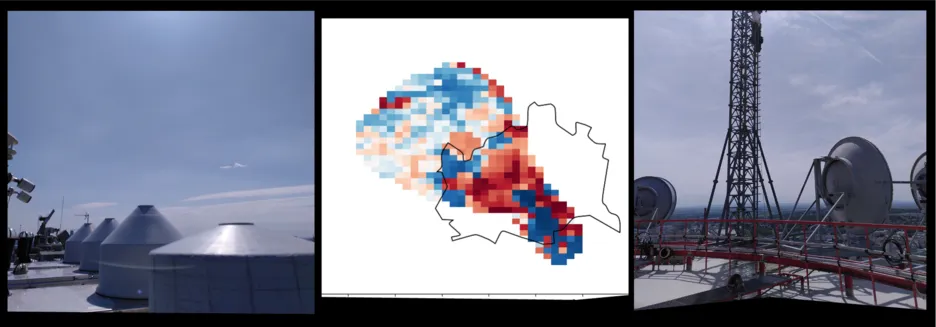
Project description
The VUCL will test the latest measurement-based emissions monitoring methods to address a pressing scientific research question with practical and political implications – Can Vienna’s greenhouse gas (GHG) emissions be adequately measured? The need for climate action in cities is critical. Systems that quantify local GHG emissions to evaluate mitigation measures are thus growing in importance and will undergo increasing levels of scrutiny. Measurement-based systems offer enormous potential; however, there is still substantial research required before they can be established within routine monitoring systems which currently rely on emission inventories. The VUCL thus proposes a number of cutting-edge scientific investigations, involving tall-tower eddy covariance measurements of net carbon dioxide (CO2) and methane (CH4) fluxes, CO2 isotope and isoflux measurements, as well as test campaigns with a differential column sensor network to measure upwind-downwind gradients in CO2 and CH4 mixing ratios.
The VUCL brings together the University of Natural Resources and Life Sciences Vienna (BOKU), the Technical University Munich (TUM), the Environment Agency Austria (EAA) and A1 Telekom Austria AG (A1) and aims to: advance science in the field of measurement-based GHG emissions estimates; showcase the latest measurement-based methods to city administrators; and lay the foundations for an adequate local monitoring system for quantifying total and sector specific emissions reductions.
The ESM-Team at TUM contributes with four Bruker FTIR EM27/SUN which are part of the MUCCNet high-precision sensor network in Munich. Further ESM research involves atmospheric transport modelling, both with Eulerian and Lagrangian models, as well as inverse modelling approaches to constrain the emissions of the city of Vienna. Based on a two month measurement campaign in Vienna in June and July 2022, we will estimate the emissions of Vienna within this period.
Project details
Project duration: 2021 - 2025
Funding: WWTF - Environmental Systems Research 2020 - Urban Regions - ESR20-030
Poland 2023
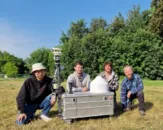
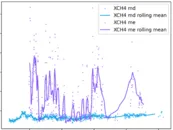

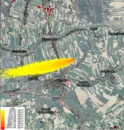
Project description
This field campaign aims at understanding the discrepancies between bottom-up and top-down emission estimates. Three instruments of the MUCCnet observatory observed single coal mine ventilation shafts in the Upper Silesian Coal Basin in the South-East of Poland for two weeks in June 2023. Our methane observations together with detailed CFD modelling will hopefully give insights on why bottom-up and top-down observations can differ. This UN-IMEO founded field campaign was conducted in close collaboration with our collegues from AGH Krakow and from the IUP Heidelberg.
Project details
Project duration: 2023 - 2025
Funding: UnitedNations - IMEO
Dense Air Quality Sensor Network in Munich
With the help of 30 self-developed sensor systems, the spatial distribution of air pollutants such as NOx, O3 and PM is monitored in the inner city of Munich.
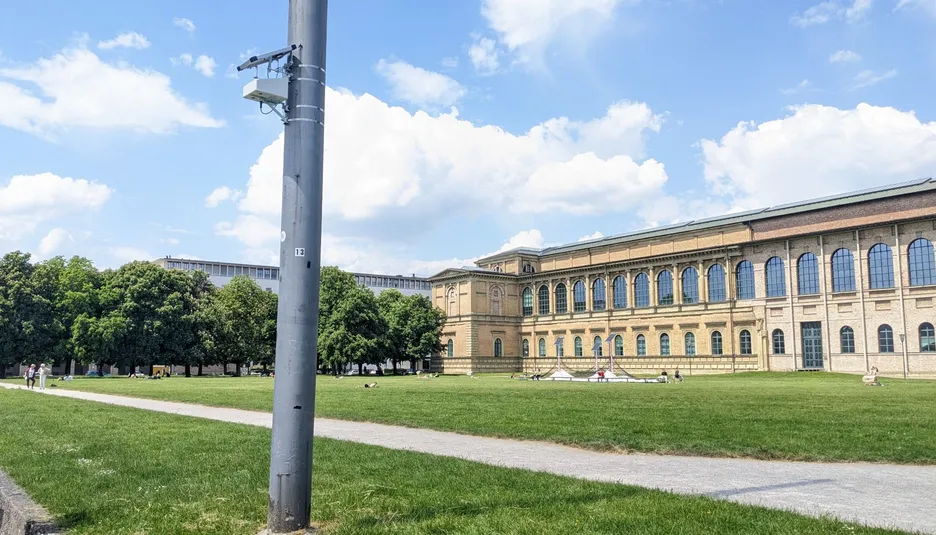
Funded by the Bavarian State Ministry of the Environment and Consumer Protection, we have set up a densely populated sensor network to measure air pollutants in Munich (Project TLK 01U-75487: Engmaschiges NO2-Sensornetzwerk in München).
Our group has developed a compact and stand-alone sensor system that is automatically measuring nitrogen dioxide (NO2), nitrogen monoxide (NO), carbon monoxide (CO), ozone (O3) and particulate matter (PM) using electrochemical cells (for all gases) and optical particle counter (for PM). All systems are connected to the internet (Internet of Things, IoT) to send their data in real-time to our server. We then analyze these data and can automatically create a real-time air quality map of the study area (around Maxvorstadt) with a high spatial and temporal resolution.
In order to ensure high data quality, the sensor are calibrated using highly accurate reference instruments that are also used in governmental air quality monitoring stations, combined with novel machine learning algorithms.
This monitoring approach will help us to understand the complex metabolism of urban air pollutants.
